#Austrian portraitists
Explore tagged Tumblr posts
Photo
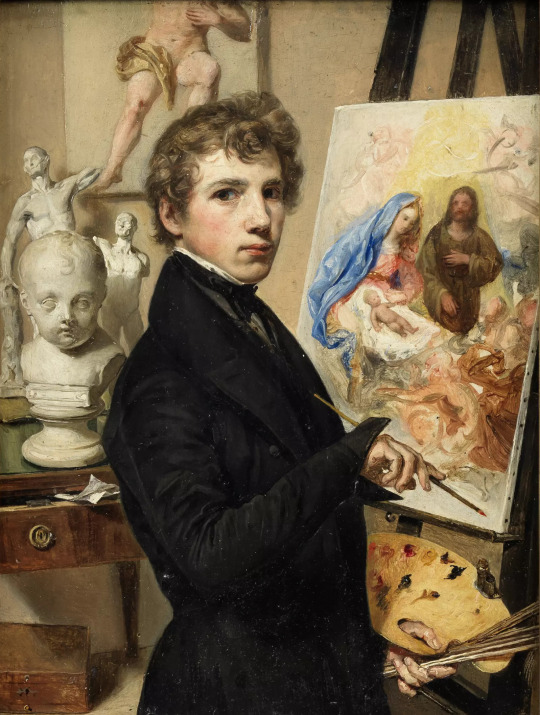
Selbstbildnis vor der Staffelei = Self-Portrait in Front of Easel Johann Baptist Reiter (Austrian; 1813–1890) 1833–36 Oil on wood Wien Museum, Vienna, Austria
#Johann Baptist Ritter#Ritter#Austrian art#Austrian artists#Austrian portraitists#Austrian portraits#Biedermeier period#Biedermeier artists#Biedermeier painters#portraits#portrait paintings#self-portraits#artists' self-portraits#painters#easels#palettes#1830s#studios#artists' studios#paintbrush#paintbrushes#Nativity#sculptures#ateliers#19th-century art#19th-century artists#19th-century Austrian art#19th-century Austrian artists
177 notes
·
View notes
Text

Portrait of Francis I of Austria
Artist: Thomas Lawrence (English, 1769-1830)
Date: 1818-1819
Medium: Oil on Canvas
Collection: Royal Collection Trust, Windsor Castle
DESCRIPTION
Thomas Lawrence was the most fashionable portraitist of his generation in Britain. He was made Principal Painter to George III in 1792 after Sir Joshua Reynolds’s death, and received occasional commissions; however it was only after 1814 that George IV began to employ him in earnest.
This portrait of the Emperor of Austria was commissioned by George IV at a cost of 500 guineas. Lawrence ventured across Europe to undertake the King's commission of a group of portraits of the allied military and political leaders involved in the Napoleonic Wars. Although Lawrence met the Emperor during the Congresses of Aix-la-Chapelle and Vienna in 1818-9, the dates during which he undertook this painting itself are not known, as it remained in the artist's studio at his death in 1830.
The Emperor is shown in military uniform with his plumed hat on a table beside him; the riband and star of the Order of the Garter worn under that of the Golden Fleece. In addition to enabling him to render details of military dress with accuracy, the artist attached particular importance to capturing his sitters from life, in order to imbue a sense of liveliness. The Emperor’s countenance, he described as 'rather long and thin, and when grave, is grave to melancholy; but when he speaks, benevolence itself lights it up with the most agreeable expressions, and making it the perfect image of a good mind.’ (letter of 5 November 1818).The conception of this group of twenty-eight portraits began in 1814 when George IV
#portrait#francis i#european#thomas lawrence#english painter#19th century painting#oil on canvas#royal collection trust#windsor castle#portraitist#austrian emperor#full length#seated#military uniform#plumed hat#table#order of the garter#red chair#drapes#history
6 notes
·
View notes
Text

The Young Eastern Woman, 1838
Artist: Friedrich von Amerling (Austrian, 1803-1887)
Medium: Oil on Fabric
Location: The Cleveland Museum of Art, Cleveland, Ohio
Description
Although the artist provocatively titled this painting Young Eastern Woman, it is obvious that the model is not Asian, but merely wears a Turkish costume. The rich fabrics and glowing light create an exotic atmosphere, revealing a Western fascination with "Oriental" images and themes.
Biography
Friedrich Amerling grew up in a poor working-class milieu and started his career illuminating maps and prints before attending the Vienna academy from 1815 until 1824. The following two years he studied at the academy in Prague, until his sojourn in London from 1827 through 1828. Amerling went to London primarily to meet the portraitist Thomas Lawrence (1769-1830), whose fame had spread throughout Europe and whose work, together with that of Joshua Reynolds (1723-1792), would form an important influence on Amerling's art. After a brief stay in Paris, during which Amerling met Vernet, he went on to Rome.
Back in Vienna he painted the life-size portrait of Emperor Franz I (1832/33, Kunsthistorisches Museum, Vienna), which, despite its mixed reviews, established his reputation as the foremost portrait painter in Vienna. From then on he received many portrait commissions from the Viennese aristocracy. In 1833 Amerling traveled to the Netherlands and, upon his return, visited the artistic centers of Munich and Düsseldorf, where he met the influential academy director Friedrich Wilhelm von Schadow (1788-1862).
Amerling's career reached its height from the 1830s through the 1850s. In the early 1840s he traveled to Rome where he worked with Leopold Pollak (1806-1880) and August Riedel (1799-1883), who influenced his work with their depictions of Italian beauties. Besides painting formal portraits, Amerling developed a painting category that remained close to portraiture but crossed over to a slightly sentimental type of genre or character painting, mostly depicting single women in coquettish poses. Although Amerling retained a certain popularity throughout his long career-he was knighted in 1879-he failed to adapt to changing artistic developments and was eventually overshadowed by artists such as Hans Makart (1840-1884).
#friedrich von amerling#oil painting#oil on fabric#austrian art#austrian artist#cleveland museum of art
13 notes
·
View notes
Text
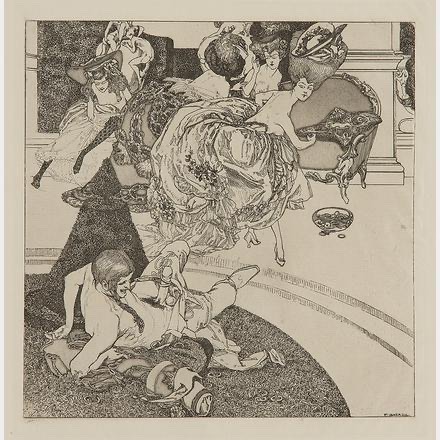
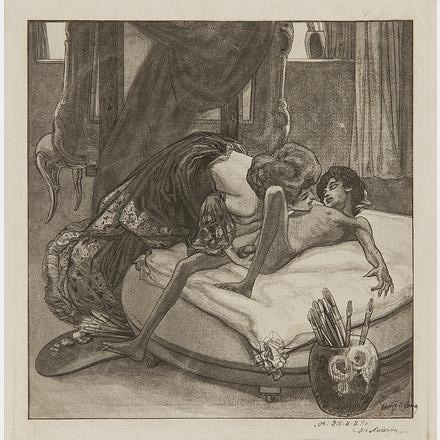
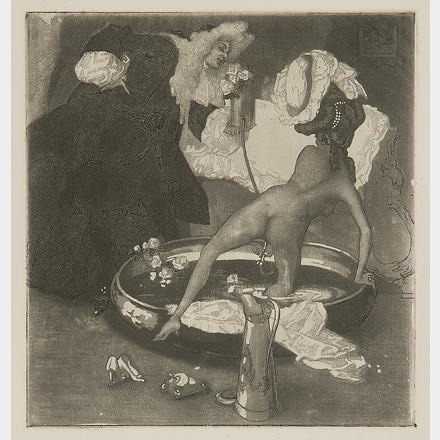
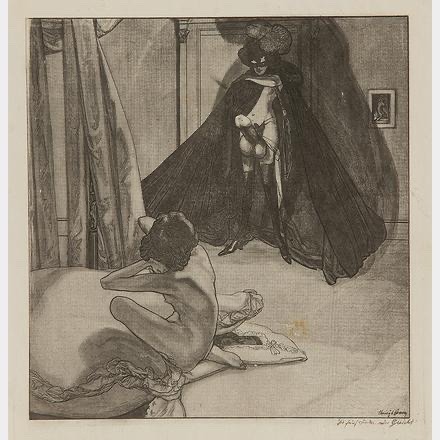

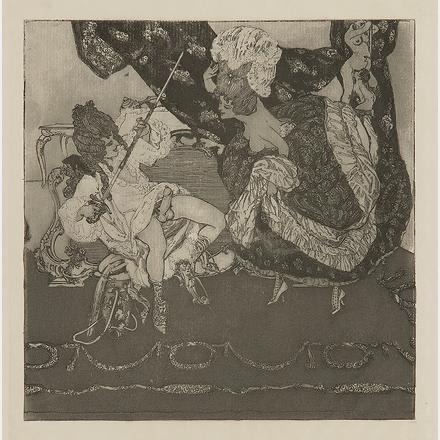
BESCHREIBUNG
FRANZ VON BAYROS (Zagreb 1866 - 1924 Wien)
Konvolut aus 6 Erotika Drucken
Ringwerfen
Aquatinta/Papier, 22,5 x 21,5 cm
signiert F. Bayros
Die Malerin
Aquatinta/Papier, 18 x 17 cm
beschriftet "Oh! DU-U-U!!" -Die Malerin-
Glühwürmchen
Aquatinta/Papier, 18 x 17 cm
betitelt "Glühwürmchen"
Die fünf Sinne
Aquatinta/Papier, 18,5 x 17 cm
beschriftet Die fünf Sinne. "Das Gesicht"
Kristie
Aquatinta/Papier, 23 x 21,5 cm
Das Schwert
Aquatinta/Papier, 22,4 x 21,5 cm
Franz von Bayros, also known as Marquis de Bayros, was an Austrian graphic artist, illustrator and painter of the fin de siècle. He also published his works under the pseudonym Choisy Le Conin. Bayros is best known as a draftsman and illustrator of erotic motifs set in the Rococo period. He came from a noble family that left Spain and settled in Austria. Bayros studied at the Academy of Fine Arts with Christian Griepenkerl and August Eisenmenger and stayed regularly in Munich. From 1890 he worked with the portraitist Eugen Felix and the landscape painter Gottfried Seelos. He moved in high circles and belonged to the circle of friends of Johann Strauss, whose stepdaughter Alice he married in 1896. The marriage ended in 1897 and Bayros moved to Munich. He studied at Adolf Hölzel's special school in Dachau and at Heinrich Knirr's school in Munich. He became involved in artistic circles and was a member of the “Vornehme Beobachter” society, which also included Thilo von Seebach, Karl Georg Maassen and Hanns Floerke. In 1904 he had his first major exhibition in Munich and subsequently took on a large number of commissions for book illustrations and bookplates. He created studies on Louis XV, studied the Rococo period and established himself as a draftsman of erotic motifs. When censorship intervened, he had to leave Munich in 1911. In Vienna he found it difficult to connect to the art market, even though he was in the circle of Rudolf Hans Bartsch, Anton Wildgans and Hugo Markus Ganz. His plans to go to Italy were interrupted by the outbreak of the First World War. On the occasion of the 600th anniversary of Dante's death, he created a collection of 60 watercolors based on the Divine Comedy, which finally brought him success in Vienna.
17 notes
·
View notes
Text

"Money In The Salon", 1930, by Pavle 'Paja' Jovanović (Serbian realist painter who painted more than 1,100 works including: The Wounded Montenegrin (1882), Decorating of the Bride (1886), The Takovo Uprising (1894), Migration of the Serbs (1896) and The Proclamation of Dušan's Law Codex (1900). As one of the best European painters of oriental scenes, Paja at the end of the 19th century turned to painting historical events of Serbian history. Paja was also the premier portraitist of Europe after 1905. He painted the Emperor Franz Joseph I of Austria 15 times, he painted royalty, major industrialists, scientists, bankers, oil barons and monopolists, including certain heirs to the Standard Oil fortune in the United States of America. He was a very sought-after portraitist world-wide, which made him incredibly wealthy in his lifetime; Born: 16 June 1859 in Vršac, Austrian Empire - Died: 30 November 1957 (aged 98) in Vienna, Republic of Austria).
2 notes
·
View notes
Text

Portrait of Countess Maria Theresia Bucquoi
Artist: Élisabeth Louise Vigée Le Brun (French, 1755 – 1842)
Genre: Portrait
Date: 1793
Medium: Oil on Canvas
Collection: Minneapolis Institute of Art, Minneapolis, Minnesota
At the age of 24, Vigée-LeBrun executed her first portrait of Queen Marie-Antoinette of France, and over the course of her career, remained the principal portraitist of the French aristocracy. On the night that revolutionaries arrested Louis XVI and his queen in 1789, Vigée-Le Brun fled France and went into exile traveling throughout Europe for 12 years.
Countess Maria Theresia Bucquoi was the daughter of Prince Johann Joseph Paar (1719-1792) and Countess Antonia Esterhazy (1719-1771), and the wife of Count Johann Josef Bucquoi (died 1803). The portrait was commissioned in 1793 by the sitter's brother, Prince Wenzel Paar. Vigée-LeBrun specifically recalls the painting in her Souvenirs when referring to the hospitality accorded to her by her Austrian patrons during her stay in Vienna. Upon its completion, the portrait was displayed in the salon of the palace of Prince Paar.
#portrait#countess#french#aristocracy#nobility#woman#elisabeth louise vigee le brun#french painter#18th century fashion#landscape#french culture#18th century painting#waterfall#mountains#trees
0 notes
Photo

Eduard Veith - Königstochter (The King’s Daughter) (c.1900)
241 notes
·
View notes
Photo

Portrait of Countess Maria Theresia Bucquoi, née Parr, Elisabeth Louise Vigée-Le Brun, 1793, Minneapolis Institute of Art: Paintings
Portrait of a woman At the age of 24, Vigée-LeBrun executed her first portrait of Queen Marie-Antoinette of France, and over the course of her career, remained the principal portraitist of the French aristocracy. On the night that revolutionaries arrested Louis XVI and his queen in 1789, Vigée-Le Brun fled France and went into exile traveling throughout Europe for 12 years. Countess Maria Theresia Bucquoi was the daughter of Prince Johann Joseph Paar (1719-1792) and Countess Antonia Esterhazy (1719-1771), and the wife of Count Johann Josef Bucquoi (died 1803). The portrait was commissioned in 1793 by the sitter's brother, Prince Wenzel Paar. Vigée-LeBrun specifically recalls the painting in her Souvenirs when referring to the hospitality accorded to her by her Austrian patrons during her stay in Vienna. Upon its completion, the portrait was displayed in the salon of the palace of Prince Paar. Size: 53 1/2 x 39in. (135.9 x 99.1cm) 61 1/2 × 47 × 3 1/2 in. (156.21 × 119.38 × 8.89 cm) (outer frame) Medium: Oil on canvas
https://collections.artsmia.org/art/2570/
5 notes
·
View notes
Photo

Commerce Counselor Ebenstein, Oskar Kokoschka, 1908, Art Institute of Chicago: Modern Art
Despite its early date (Oskar Kokoschka described it as his second finished painting), this portrait already reveals the artist's great gifts as a portraitist and the hallmarks of his highly personal form of Expressionism. Like Max Beckmann and Chaim Soutine, Kokoschka used calculated distortions of line and color in a highly individual manner to give emotional force to his paintings. As a student in Vienna, he was influenced not only by the German Expressionist artists of Die Briicke (The Bridge), but also by Gustav Klimt and by Jugendstijl art, as shown by the sensitive, nervous line and the touch of melancholy that came to characterize his work.Kokoschka met his sitter through the avant-garde architect Adolf Loos, who introduced him to Vienna's high society and thus provided him with subjects for a penetrating series of portraits. As tailor to the Austrian imperial court, Ernst Ebenstein was one of the most accomplished and admired members in the world of Viennese high fashion. During a visit to the Art Institute in 1958, Kokoschka remembered him as kind and generous. Ebenstein had offered to make the artist some clothes and had taught him a great deal about anatomy based on his sartorial experience as a perceptive observer of the human body. Kokoschka's affection for his sitter seems to be reflected in the compassionate yet unflinching honesty with which he recorded the signs of age on his face and hands. The sitter has been caught in a moment of relaxed introspection, his gaze averted from the viewer, his social persona momentarily laid aside to reveal his inner self. Even the sitter's impeccable black attire has a crumpled, weathered quality that bespeaks human vulnerability and frailty. As in other portraits by Kokoschka, the hands constitute a psychological focus as strong as that of the face. The artist's expressive distortions are especially evident here. Painted in a vivid orange, these gnarled and bony hands seem to express the man's very essence and become the locus of his professional and psychological identity. —Entry, Margherita Andreotti, Art Institute of Chicago Museum Studies, Vol. 20, No. 2, The Joseph Winterbotham Collection at The Art Institute of Chicago (1994), p. 136-137. Joseph Winterbotham Collection Size: 40 1/16 × 31 15/16 in. (101.8 × 81.1 cm) Medium: Oil on canvas
https://www.artic.edu/artworks/2893/
4 notes
·
View notes
Photo

Francois Xavier Joseph Jacquin - Portrait of a boy - 1806
François Xavier Joseph Jacquin or Frans Jaquin (Brussels, 1756 – Leuven, 1 November 1826) was a Flemish painter and draughtsman known for his portraits, still lifes and landscapes. He was in demand as a portrait painter of religious dignitaries, the nobility and the bourgeoisie. As a still life painter he created game pieces and trompe-l'œil still lifes of game birds.
François Xavier Joseph Jacquin was born in Brussels. He commenced his art studies at the Académie Royale des Beaux-Arts in 1768 and later moved to Antwerp where he trained in the workshop of Hendrik-Jozef Antonissen, a painter of landscapes and cattle. Here he also befriended the landscape painter Balthasar Paul Ommeganck. He moved to Leuven in 1776 where he became a student of Laurent Geedts, a still life painter.
He married Anna Maria Simons of Leuven in 1777. The couple had 14 children of whom only two survived into adulthood.
He initially devoted himself to still lifes and then from 1780 onwards he became in demand as a portrait painter. After gaining a commission to paint Simon Wouters the prelate of the Park Abbey in Heverlee near Leuven, he was able to obtain many further commissions from religious dignitaries including the archbishop of Mechelen Franckenberg and of professors of Leuven University. These portrait commissions kept him particularly busy.
He painted a portrait of the Austrian Emperor Francis II for the city hall of Leuven in 1792. This work was engraved by Antoine Cardon and displayed in the city hall of Leuven where it was burnt on 21 January 1795 by citizens of Leuven. He became the appointed portraitist of the notables and bourgeois of Leuven but also recruited his clientele in Hainaut, Brabant and The Netherlands. After the invasion of the Southern Netherlands by the French in 1794, Jacquin's commission work dried up and he gave up painting to trade in wine and cloth.
Jacquin was together with Josse-Pieter Geedts, Frans Berges, Pieter-Jozef Verhaghen, Pieter Goyers, Martin van Dorne and Antoon Clevenbergh one of the founders of the Academy of Fine Arts of Leuven in 1800. After the founding of the Academy, Jaquin's artistic career took off again and he re-established himself as a portrait painter to the world of merchants and the middle classes of Leuven.
One of his pupils at the Academy was Henri van der Haert. He died on 1 November 1826 in Leuven.
6 notes
·
View notes
Photo

Viktor Oskar TILGNER (1844-1896) “Josefine POLLAK” (1874) Marmor / Marble - on view at the BELEVDERE VIENNA. Viktor TILGNER was an Austrian sculptor and portraitist - most important representative of Viennese late historicism in the field of sculpture. Viktor TILGNER war ein österreichischer Bildhauer und Porträtist und gilt als bedeutendster Vertreter der Bildhauerei des Wiener Späthistorismus.
#viktor tilgner#belvedere vienna#vienna#historicism#wien#historismus#neo baroque#neo barock#vienna 1900#wien 1900#belvedere#sculpture
22 notes
·
View notes
Photo
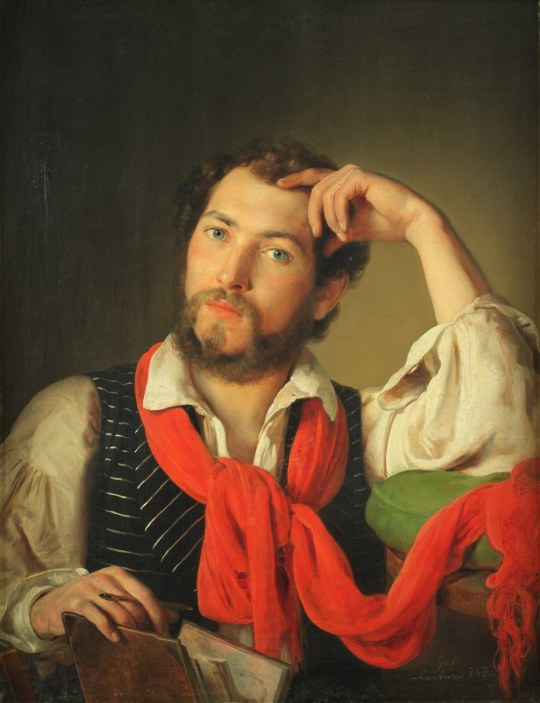
Selbstbildnis mit rotem Schal = Self-Portrait with Red Scarf Johann Baptist Reiter (Austrian; 1813–1890) 1842 Oil on canvas Oberösterreichisches Landesmuseum, Linz, Austria
#Johann Baptist Ritter#Ritter#Austrian art#Austrian artists#Austrian portraitists#Austrian portraits#Austrian paintings#Biedermeier period#Biedermeier artists#Biedermeier painters#portraits#portrait paintings#self-portraits#artists' self-portraits#painters#1840s#pencils#19th-century art#19th-century artists#19th-century Austrian art#19th-century Austrian artists#artists#scarf#scarves#vests#beards#sketchbooks#artists' portraits#19th century
25 notes
·
View notes
Photo

Marie Therese, Daughter of Louis XVI and Marie-Antoinette
Acquired in April 2019, at Parisian antique trade, this, of highest quality large miniature on vellum is one of the most important graphic works of Vienna court portraitist of late 18th century, Josef Kreutzinger.
Moreover, it is executed by the latter in spring of 1799 (shortly before sitter's departure from Vienna) preparatory drawing for a large-scala oil portrait of the famous French royalty, 19-year-old daughter of Louis XVI and Marie Antoinette, Princess Marie Therese Charlotte de France, Madame Royale. As known she spent 3,5 years in Vienna. She came to this city on January 9th 1796, twenty-two days after leaving the Temple (her prison in Paris, where she spent 3 years: at first, with her whole family and, toward the end, alone, the only surviving member of this family; on December 18th 1795 she was liberated - she was exchanged for Nicolas Marie Quinette, Baron de Rochemont captured by the Austrians.
On 2nd May 1799 she left Vienna and moved to Mitau (then Russian town in the province Courland; now Yelgava in Latvia), where she was awaited by her fiancé, Louis Antoine Duke of Angouleme (son of Comte d'Artois and, respectively, her first cousin).Their wedding took place there already in June. In next year Kreutzingert finished his oil portrait of her (obviously lost!) which is known today only through engraving by Kreutzinger's co-laborateur, Vienna artist Johann Neidl.
#marie therese charlotte#madame royale#french monarchy#18th century#house of bourbon#Josef Kreutzinger#long live the queue
100 notes
·
View notes
Photo

Jean-Baptiste Philibert Vaillant, 1st Comte Vaillant (6 December 1790 – 4 June 1872), born in Dijon, was a Marshal of France.
19th century carte de visite. Vaillant entered the French army in 1809 in the corps of engineers. He served in the French invasion of Russia (1812) and the next year became a prisoner of war after the Battle of Kulm. During the Hundred Days Vaillant fought at Ligny and Waterloo. Vaillant commanded a battalion in the 1830 campaign against Algiers. Promoted to lieutenant colonel, he served under Gérard in the expedition into Belgium in 1831.
Vaillant commanded the fortress at Algiers from 1837 to 1838, recalled to France, he was made director of the École polytechnique. Promoted to lieutenant general, Vaillant was put in charge of the building of the Parisian fortifications in 1845 under the command of Dode de la Brunerie. In 1849, Vaillant was given command of the engineers in the French expeditionary corps to Rome. Promoted to Marshal of France in 1851, Vaillant served as Minister of War from 1854 to 1859, holding the position throughout the Crimean War. On the outbreak of the Franco-Austrian War he resigned as Minister of War in order to serve as Chief of Staff to Napoleon III, who took personal command of the French Army. In 1860, Vaillant became minister responsible for the Imperial House and in 1864, he was made Grand Chancellor of the Legion d'Honneur. After the fall of the Second French Empire in September 1870, Vaillant was banished from France but was allowed back, returning in 1871. He died in Paris the next year.
Émile Jean-Baptiste Philippe Bin (10 February 1825 – 4 September 1897) was a French portraitist, mythology painter, watercolorist and politician.
He initially worked as a decorative painter, specializing in hotels throughout Paris and Reims (including the great hall of the Hôtel du Louvre, which he did together with his uncle), but also worked at the National Museum of Natural History, the École Supérieure de Pharmacie, the Crédit Mobilier, the Church of Saint-Sulpice and some private residences such as the Louis XV Salon of André Adolphe Eugène Disdéri. At the International Exposition (1867), he collaborated on decorating the Egyptian Pavilion, designed by Jacques Drevet, for which he was awarded the Order of the Medjidie. In 1871, he received three commissions from Russia. He was a fervent admirer of the works of Michelangelo and Raphael, and visited Rome in 1866, accompanied by his star pupil and sometime collaborator, Joseph Blanc, reinforcing his interest in historical and anecdotal scenes and his predilection for mythological nudes.
During the Siege of Paris in 1870, he was appointed to the Council of Armaments and Supplies, but refused to take part in the Commune and retired to Argentan. He remained anticlerical and close to the extreme radical left.
He was named a Knight of the Légion d'honneur in 1878. Two years later, he was one of the founders of the Société des Artistes Français and, the following year, the Salon des Artistes Français. Among his best-known students were Charles Léandre, Paul Milliet, Henri Rivière and Paul Signac.
12 notes
·
View notes
Photo










Madame d’Ora
edited by Monika Faber with preface by Ronald Price and contribution by Katrin Bomboll, Christian Brandstätter , Jean-Marc Dreyfus, Monika Faber, Esther Ruelfs, Lisa Silverman and Magdalena Vukotic
Prestel, Munich/London/New York 2020, 232 pages, 8 color illustrations, 200 b/w illustrations, ISBN: 978-3-7913-5970-0
euro 58,00
email if you want to buy :[email protected]
Discover the oeuvre of legendary fashion and society photographer Madame d’Ora, who with her work documented both the glamour and the tragedy of 20th century Europe. Born Dora Kallmus (1881-1963), the Austrian fashion and portrait photographer took the pseudonym Madame d'Ora. She was the most acclaimed portraitist of the fin-de-siècle Vienna, and went on to create one of the most stylish Art Deco studios in Paris in the 1920s. Her models included #JosephineBaker, #CocoChanel, #Colette, and #PabloPicasso, among many others. This catalogue covers the primary periods of her life and career, from her early upbringing as the daughter of Jewish intellectuals in Vienna, to her days as a premier celebrity and society photographer first in Vienna and later in Paris. It also discusses her survival during the Holocaust and her work photographing refugees in the aftermath of World War II, including a remarkable and searing group of photographs documenting Parisian abattoirs. This publication accompanies the largest exhibition devoted to Madame d'Ora ever presented in the United States, on view at the Neue Galerie New York from February 20 to June 8, 2020.
29/03/20
orders to: [email protected]
twitter: @fashionbooksmi
flickr: fashionbooksmilano
instagram: fashionbooksmilano
tumblr: fashionbooksmilano
#Madame D'Ora#photography books#libri di fotografia#fashion photographer#society photographer#Dora Kallmus#fin-de-siècle Vienna#Paris Art Deco#fashion history#fashion inspirations#fashion books#fashionbooksmilano
10 notes
·
View notes
Text
Can’t resist an urge to temporally act as that annoying individual who wants to intervene just because “what about 19th century men depicted in the exact same manner and are there even any at all” ?
It seems especially relevant after our recent visit to the State Historical Museum, where we were lucky enough to locate a portrait which suits the theme of “an empire-styled person with the harp” perfectly. ✨


It’s a portrait of a young gentleman drawn in 1801 by the Austrian portraitist Ludwig Guttenbrunn (1750 - 1819).
One of their many protégés, he worked for a while for the most prominent Hungarian dynasty in the Habsburg’s monarchy, Esterházy de Galántha, then travelled and studied a lot in Italy and England, until in 1795, on the recommendation of the Russian envoy in London, he moved to Saint Petersburg and later to Moscow.
Through years he was able to depict a fair amount of Russian noblemen and women, including this charming young man, Nikolay Mikhailovich Gusyatnikov, who originated from a wealthy family of merchants, highly regarded in Moscow, and lately became the first one in his family to be elevated to the noble dignity thanks to his military service.



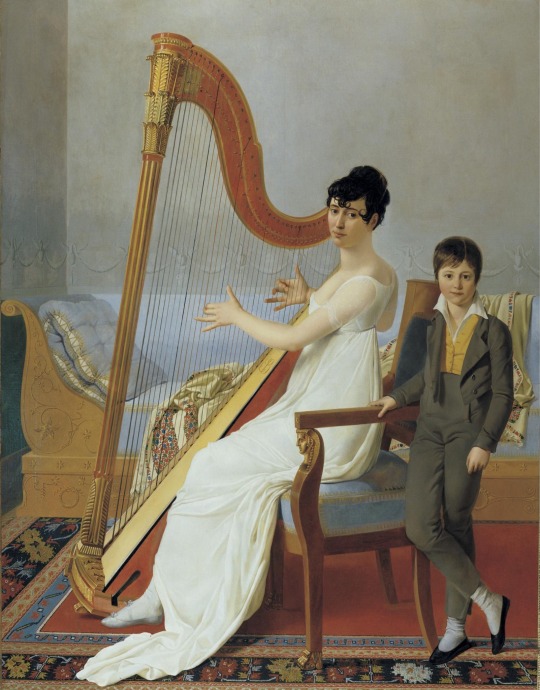


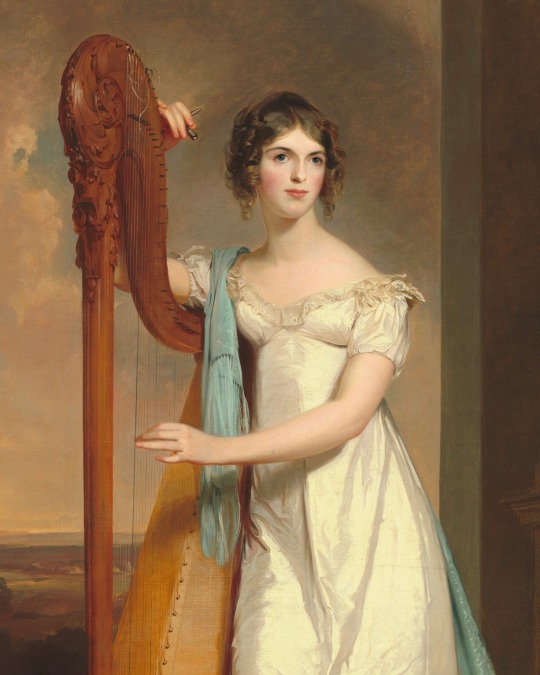

Women playing the harp during the Napoleonic era, early 19th century
#1800s art#historical fashion#men’s fashion#harp#empire style#napoleonic era#russian empire#19th century#1800s
193 notes
·
View notes